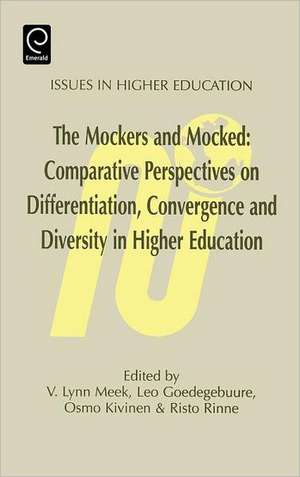The Mockers and Mocked;conparative Perspectives on Differentation, Convergence and Diversity in Higher Education: Sociological Study on Tourism (Tourism Social Science S.): Tourism Social Science
Autor L. Meek, L. Goedegebuure, O. Kivinenen Limba Engleză Hardback – 16 dec 1996
The empirical part of the book contains eight country studies. These analyses provide detailed insights into the processes that have affected differentiation in these countries. They also provide the basis for an analysis of the theoretical arguments from a comparative perspective. The concluding chapter is an analysis of the conditions which influence change within higher education institutions and systems, and what the effects of these changes are in terms of diversity.
Preț: 793.32 lei
Preț vechi: 1030.28 lei
-23% Nou
Puncte Express: 1190
Preț estimativ în valută:
151.85€ • 164.100$ • 127.64£
151.85€ • 164.100$ • 127.64£
Carte tipărită la comandă
Livrare economică 21 aprilie-05 mai
Preluare comenzi: 021 569.72.76
Specificații
ISBN-13: 9780080425634
ISBN-10: 0080425631
Pagini: 256
Ilustrații: Illustrations
Dimensiuni: 156 x 234 x 16 mm
Greutate: 0.54 kg
Ediția:New.
Editura: Emerald Group Publishing Limited
Seria Tourism Social Science
ISBN-10: 0080425631
Pagini: 256
Ilustrații: Illustrations
Dimensiuni: 156 x 234 x 16 mm
Greutate: 0.54 kg
Ediția:New.
Editura: Emerald Group Publishing Limited
Seria Tourism Social Science
Cuprins
Introduction. On diversity, differentiation and convergence (L. Goedegebuure et al.). Theoretical Perspectives. Diversification of higher education: viability and change (B.R. Clark). Homogenization, integration and convergence: the cheshire cats of higher education analysis (G. Neave). Isomorphism in higher education? Towards a theory of differentiation and diversity in higher education systems (F. van Vught). Country Experiences. Diversity and differentiation in the Australian unified national system of higher education (V.L. Meek, A. O'Neill). Diversity within a decentralized higher education system: the case of Canada (G. Jones). The problem of diversification in higher education: countertendencies between divergence and convergence in the Finnish higher education system since the 1950s (O. Kivinen, R. Rinne). Diversity in higher education in Germany: the two-type-structure (U. Teichler). Diversity in the Netherlands (J. Huisman). From equality through equivalence to quality through diversification: changes in the Swedish higher education policy in the 1990s (M. Bauer). Differentiation and diversity in a newly unitary system: the case of the United Kingdom (O. Fulton). Diversification in American higher education: historical patterns and current trends (R.L. Geiger). Conclusion (V.L. Meek et al.).
Recenzii
Martin Hayden, Southern Cross University
This book makes an important contribution to the literature on policy studies in higher education because of the quality of the contributions, the status of the contributors and the importance of the topics addressed. The book provides and extraordinarily rich insight into the remarkable diversity across, and within, national higher education systems and it presents a great deal of evidence that, over time, these systems can shift one way and then the other in terms of the amount of diversity they exhibit. I regard the book as being valuable for anyone with an interest in higher education systems generally and as an essential text for scholars exploring the dynamics of structural change within, and across, national higher education systems.
Higher Education Research & Development
This book makes an important contribution to the literature on policy studies in higher education because of the quality of the contributions, the status of the contributors and the importance of the topics addressed. The book provides and extraordinarily rich insight into the remarkable diversity across, and within, national higher education systems and it presents a great deal of evidence that, over time, these systems can shift one way and then the other in terms of the amount of diversity they exhibit. I regard the book as being valuable for anyone with an interest in higher education systems generally and as an essential text for scholars exploring the dynamics of structural change within, and across, national higher education systems.
Higher Education Research & Development












